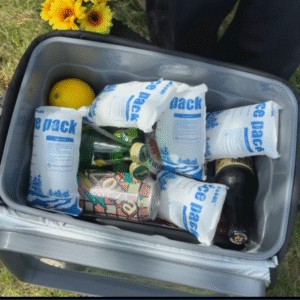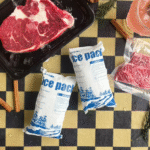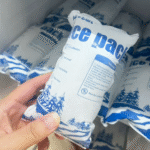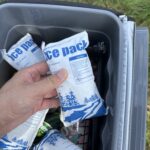Envío de paquetes de hielo seco y ladrillos de hielo seco: A Complete Guide to 2025 Mejores prácticas
When shipping temperature-sensitive products across international borders, reliable cold chain logistics are crucial. Dry ice pack and dry ice bricks shipping offer solutions that maintain ultra-low temperatures for extended periods. This guide will help you understand how dry ice is used in shipping, the best practices, and the regulations to follow in 2025 for successful and compliant shipments.

-
The difference between dry ice packs and dry ice bricks
-
How to use dry ice for global shipping and compliance
-
Key regulations for dry ice shipping worldwide
-
Tips for optimizing packaging and shipment duration
-
Emerging trends in dry ice shipping
What Are Dry Ice Packs and Dry Ice Bricks, and How Do They Work in Shipping?
Paquetes de hielo seco y ladrillos de hielo seco are both forms of solid carbon dioxide, used to maintain extremely low temperatures during transport. They sublimate directly into carbon dioxide gas, providing cooling without the mess of water residue. Both are ideal for shipping goods that require frozen conditions, como los productos farmacéuticos, mariscos, y muestras biológicas.
El hielo seco se sublima a -78.5 ° C, keeping items at a constant temperature for hours or days, depending on the shipping method and package insulation.
Key Differences Between Dry Ice Packs and Dry Ice Bricks
| Característica | Paquetes de hielo seco | Ladrillos de hielo seco |
|---|---|---|
| Forma | Flexible sheets or pre-cut pieces | bloques rígidos, heavier in weight |
| Uso | Best for shorter shipping durations | Ideal for longer transit or heavier shipments |
| Duración del enfriamiento | más corto (12-48 horas) | Más extenso (arriba a 72 horas) |
| Flexibilidad | Can be easily adjusted to fit smaller spaces | Best for larger, more rigid containers |
Why Use Dry Ice Packs and Dry Ice Bricks for Global Shipping?
Shipping with paquetes de hielo seco y ladrillos de hielo seco ensures that perishable products remain safe during long-distance travel. Their cooling power is unmatched for goods like:
-
Productos farmacéuticos & Biotecnología: Vacunas, muestras de sangre, y biológicos
-
Alimentos Congelados: Mariscos, carnes, y verduras congeladas
-
quimicos: Products requiring a constant, baja temperatura
What Benefits Do Dry Ice Packs Offer Over Other Refrigerants?
-
Sin residuos de agua: A diferencia del hielo normal, dry ice sublimates without melting, preventing water damage to sensitive products.
-
Enfriamiento extendido: Dry ice maintains temperatures for days, which is crucial for international shipping where transit times can vary.
-
Versatilidad: Dry ice is ideal for a wide range of temperature-sensitive goods, from vaccines to frozen meals.
What Regulations and Compliance Do You Need for Dry Ice Shipping in 2025?
International Regulations for Dry Ice Shipping
El hielo seco se clasifica como Y 1845 under hazardous materials by the Asociación Internacional de Transporte Aéreo (IATA) y el Departamento de Transporte (PUNTO). Shipping dry ice requires careful adherence to packaging, etiquetado, and handling regulations to ensure safety and compliance.
Requisitos regulatorios clave:
-
Etiquetado adecuado: All dry ice shipments must be labeled with “Hielo seco” o “Dióxido de carbono, Sólido” and include the UN 1845 número.
-
Weight Restrictions: IATA limits dry ice to 200 kg por bulto en aviones de pasajeros.
-
Ventilación: Packaging must be designed to allow the gas to escape to prevent pressure buildup and rupture.
Handling Dry Ice for International Shipments
-
Calculate the Correct Amount: Ensure the right amount of dry ice based on shipping duration and goods temperature requirements.
-
Etiqueta y documento: Include essential documentation like net dry ice weight, hazardous material labeling, and shipping destination details.
-
Vent Packaging: Utilice siempre envases ventilados, such as perforated boxes or vented cooler bags.
Las mejores prácticas para el envío de hielo seco
Choosing the Right Dry Ice: Pack or Brick?
The choice between paquetes de hielo seco y ladrillos de hielo seco depende de varios factores:
-
Duración de envío: Usar ladrillos de hielo seco for longer shipments (48+ horas) y paquetes de hielo seco para viajes más cortos (24-48 horas).
-
Tamaño del paquete: Dry ice packs are ideal for smaller, flexible spaces, while dry ice bricks are best for rigid, larger containers.
Packaging for Dry Ice
To optimize envío de hielo seco, follow these packaging tips:
-
Use contenedores aislados: Protect the dry ice from external temperature changes with well-insulated boxes or cooler bags.
-
Allow Gas Venting: Ensure containers are not airtight to prevent the buildup of carbon dioxide gas.
-
Monitoreo de temperatura: Use IoT-enabled sensors to monitor the temperature during transit for added security.
Global Shipping Considerations for Dry Ice Packs and Dry Ice Bricks
Environmental Impact of Dry Ice Shipping
A medida que la sostenibilidad se vuelve más importante, the cold chain logistics industry is adopting embalaje ecológico y reusable cooler bags to minimize environmental impact. Considere usar materiales reciclables for packaging and ensure that carbon dioxide emissions are minimized through energy-efficient cold storage solutions.
Customs and Import Regulations
Different countries have varying regulations for envío de hielo seco. Always verify the destination country’s customs policies y regulaciones de materiales peligrosos antes del envío. Some regions have specific guidelines on the quantity of dry ice allowed in shipments, as well as the documentation required for clearance.
2025 Tendencias en el envío de hielo seco: What to Expect
Innovaciones Tecnológicas
The dry ice shipping industry is evolving with advanced technologies, como:
-
Soluciones de envío inteligentes: IoT-enabled containers that provide real-time tracking and temperature monitoring.
-
Sustainable Shipping Materials: El ascenso de reusable dry ice cooler bags y embalaje ecológico materiales.
Regulatory and Market Shifts
-
Increased Compliance: Governments worldwide are tightening regulations, making compliance critical for businesses engaged in international shipping.
-
Growth of E-commerce: As global e-commerce continues to boom, demand for reliable, temperature-sensitive shipping solutions like dry ice will only increase.
Preguntas frecuentes (Preguntas frecuentes)
Q1: How much dry ice do I need for a 48-hour shipment?
For a 48-hour shipment, necesitarás aproximadamente 10-15 libras de hielo seco. Adjust based on the insulation of your packaging and external temperature conditions.
Q2: Can I ship dry ice through USPS?
USPS allows dry ice for domestic shipments but restricts it to 5 libras por paquete. Para envíos internacionales, use carriers like FedEx or UPS that offer specific dry ice services.
Q3: ¿Cuánto dura el hielo seco en el envío??
El hielo seco generalmente dura entre 18-72 hours depending on the size of the shipment, aislamiento, y temperatura ambiente. Larger shipments and thicker insulation can extend the cooling duration.
Summary and Conclusion
En 2025, dry ice pack and dry ice bricks shipping offer an essential solution for transporting temperature-sensitive goods worldwide. Adhiriéndose a las mejores prácticas, garantizar el cumplimiento de las normas, and selecting the correct type of dry ice, you can ensure that your perishable products reach their destination safely and efficiently.
Consejo práctico: Always verify shipping regulations and use reliable packaging for dry ice to ensure safe and on-time delivery. Consider integrating IoT-enabled monitoring systems to enhance visibility and compliance during shipment.
Acerca de Tempk
En Templ, Nos especializamos en brindar soluciones de vanguardia en cadena de frío., incluido paquetes de hielo seco, ladrillos de hielo seco, and temperature-sensitive shipping products. Our goal is to help businesses ensure the safety and integrity of their shipments with reliable, eficiente, and compliant cold storage solutions.
Need help with dry ice shipping? Contáctenos hoy para optimizar la logística de su cadena de frío.























